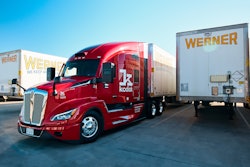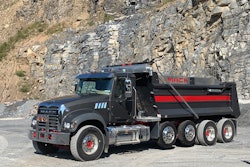The idea of autonomous trucking was one born as a solution to a national shortage of truck drivers that currently sits at around 80,000, according to the American Trucking Associations, and could reach 160,000 by 2030 – the same year many autonomous tech companies expect their platforms to be mature and ready for primetime.
Joining Jason and Matt this week on CCJ's 10-44 is Andrew Culhane, chief strategy officer at Torc Robotics, an autonomous tech company in which Daimler Truck North America has an ownership stake.
The pandemic threw global supply chains into upheaval, and nearly two years later they still aren't fully recovered. Culhane said, while not a "silver bullet," autonomous driving technologies could unlock efficiencies that not only ease a shortage of CDL drivers, but also shore up gaps in the supply chain.
Contents of this episode
00:00 Supply chain issues and autonomous trucks01:41 Improved capabilities of autonomous trucks
03:10 Reaching level 4 autonomy
06:24 Using autonomy to increase capacity
07:13 The S-curve of adopting autonomy
08:10 Autonomous technology could attract more people to the trucking industry
Video transcript
Jason Cannon
Is autonomy shifting from driver shortage solution to being the missing link in the supply chain? The 10-44 takes a look.
Jason Cannon
Hey everybody, and welcome to the 10-44 a weekly webisode from the editors here at CCJ. I'm Jason Cannon, and my co-host on the other side is Matt Cole. We all got a good look at what could happen to the supply chain in 2020, and we just narrowly avoided it again with a rail strike last month that, thankfully, didn't come to fruition. The trucking industry is freight rail's largest customer and hanging in the balance of a would-be strike was an outcome on the flow of goods that would've rivaled a natural disaster.
Matt Cole
It doesn't take something with the magnitude of a global pandemic to show just how vulnerable the U.S. distribution network is. We're just past the peak of the Atlantic hurricane season, and we're likely to get a snapshot of it a few times between now and December.
Jason Cannon
Autonomous trucks have long been hailed as a solution to the shortage of truck drivers, but it could potentially also be a reliable link in the supply chain by automating hub to hub middle mile segments. At the very least, they could be a part of the recipe that shores up supply chains. That's according to Torc Robotics Chief Strategy Officer, Andrew Culhane.
Andrew Culhane
There is not just one piece of this that any single technology solves or unlocks. And so, I think self-driving trucks and really adding some middle mile capacity helps that equation. In no way does it solve it, right? It's far too complex for one technology to just unlock everything. So, I think it's a bit of both. But it's a really amazing opportunity in that context, right?
Matt Cole
Autonomous capabilities have grown by leaps and bounds in the last 10 to 15 years. Current technology is capable of much more, including previously human exclusive functions, like lane centering, steering and braking. But there's also been a more refined approach by tech companies that has enabled more successes.
Andrew Culhane
If I look back even five years ago with trucking or anything that was truly over the road, we didn't have clear line of sight on that commercialization path, both from a market adoption side, but also really from the technology, whether we're talking about the sensors, the compute, getting the chassis that are safety rated. And I think what we finally have now is all of those things coming together, right? We see the timelines for whether they're lidar, radar, cameras, computers, all of those aspects.
From Torc's perspective, we have this amazing partner with DTNA and the autonomous-ready Cascadia they're building up, and we see clear line of sight to get that built. But then, from the application side, self-driving is an industry that has regularly overextended itself, right? We're going to solve all problems and all driving domains all over the world. And we're seeing this really narrow focused application, at least for us, that is hub to hub, long haul over the road, moving that middle mile of goods, and able to focus on those. And I don't think we had all of those ingredients in the past. But now as an industry, we're getting closer to that.
Jason Cannon
A lot of buy-in is going to be needed for wide adoption of "driverless trucks," buy-in from regulators, from fleets, from tech companies, and the motoring public.
Andrew Culhane
When we're looking at it, we're looking at what they would call level four, right? So, as a system that can drive in a prescribed operational design domain. So, certain weather, certain geographies, certain road structures. And so for us, we're trying to keep that, I'll say, as narrow as can be focused. And that comes with continued advances in the technology, that comes with continued advances of how we validate these, right? There's a lot of conversation, even around passenger cars and consumer vehicles, about what is safe enough for whether it's a level two system, level three system, or level four. Ultimately, that leads into the regulatory and public trust. Take our application, it's a 80,000 pound commercial vehicle on the highway. That takes a tremendous amount of trust from the public to even allow that to go down the road. And so, we're seeing all those things moving in parallel, and that's the good news, right?
Andrew Culhane
There's not one thing that's lagging behind. But all of those things do need to move forward to where we can get to truly taking the driver out in a meaningful way on public roads. This is one of those rare applications where I actually think the launch of true level four technology is accelerated in trucking in advance of passenger car. And so, what I think we're going to see is that the level four technology, and you're seeing it with a lot of the players, the autonomy space is actually better suited for trucking than it is for passenger car today. And so, this is one of those odd instances where I think trucking is leading the way in technology over passenger car.
Matt Cole
The Association of American Railroads estimated that 460,000 additional long haul trucks would be needed every day to offset the effects of a railroad strike that did not ultimately happen. That number of trucks is just not feasible, autonomous or not. Interest in autonomy is unlikely to provide a solution for a major event like that, but it does help fill in the gaps. He tells us how after this word from 10-44 sponsor Chevron Lubricants.
Protecting your diesel engine and its after treatment system has traditionally been a double edged sword. The same engine oil that is so essential to protecting your engine's internal parts is also responsible for 90% of the ash that is clogging up your DPF and upping your fuel and maintenance costs. Outdated industry thinking still sees a trade off between engine and emission system protection, and Chevron was tired of it. So, they spent a decade of R&D developing a no compromise formulation. Chevron Lubricants developed a new ultra low ash diesel engine oil that is specifically designed to combat DPF ash clogging.
Delo 600 ADF with OmniMax technology cuts sulfate ash by a whopping 60%, which reduces the rate of DPF clogging and extends DPF service life by two and a half times. And just think what you can do with all the MPGs you're going to add from cutting your number of regens. But Delo 600 ADF isn't just about after treatment. It provides complete protection extending drain intervals by preventing oil breakdown. Before you had to choose between protecting your engine or your after treatment system, and now you don't. 600 ADF from Delo with OmniMax technology. It's time to kick some ash.
Andrew Culhane
It is not some silver bullet that solves capacity issues for rail or other major disruptions, but it does provide some significant capacity that you could utilize there. When we look at it in that aspect, that middle mile, that hub to hub is a pretty big shift, though, in terms of the way most freight moves today, even if it's still over the road, right? Your traditional truck load, as you mentioned, is irregular route, dock to dock, and the middle miles. The easy part, right? You're just driving down the highway. But the reality is those are also the drivers that have a lot of the weeks and months away from home and other labor type challenges. And so, if we can offset that middle mile with a nice, fixed, steady capacity, you can leverage the existing driver base more in a regional or super regional aspect.
Jason Cannon
Andrew estimates the wide adoption of autonomous trucks will be underway by the end of this decade, and that's a timeframe that I've heard estimated by many driverless tech companies. But of course, fleets, drivers, and their customers all get a vote, too.
Andrew Culhane
Also, it has to do with what is the adoption curve in the traditional carrier market, right? They don't just change their fleets out overnight. They don't completely restructure all their contracts overnight. So, we expect even once you get a driver out, we always talk about some s-curve for adoption, right? But that's pretty traditional in most industries, and I think that's what it's ultimately going to come down to is building the trust throughout this whole ecosystem, right? The shippers have to trust that their goods are going to get delivered and get delivered safely because their name is attached to it. The carriers also have to trust that they can meet their SLA obligations and that this technology, again, is safe and meets all regulatory requirements, right? The public has to allow for it and, and, and, right? So, you go down this list, and I think that's the big one.
Matt Cole
While autonomy could play a role in alleviating some of the pains associated with the driver shortage, it could also be seen as a contributing factor. Why would anyone want to seek out a job knowing it's going to be automated? But Andrew doesn't see it that way at all. In fact, he thinks the automation is a tool that can be used to attract more people to the industry.
Andrew Culhane
Whether you're able to focus on higher end skills and technology around mission control and service and maintenance of autonomous trucks, we hope that it actually makes the industry more appealing to work in. Almost closer to something like the airline industry where pilots, and you can see it even in DOD, where things like drone pilots and service and maintenance and all this advanced technology has actually elevated the industry. That's our hope.
Jason Cannon
That's it for this week's 10-44. You can read more on ccjdigital.com. And as always, you can find the 10-44 each week on CCJ's YouTube channel. If you've got questions, comments, criticism, or feedback, please hit us up at [email protected] or give us a call at (404) 491-1380. Until next week, everybody stay safe.











